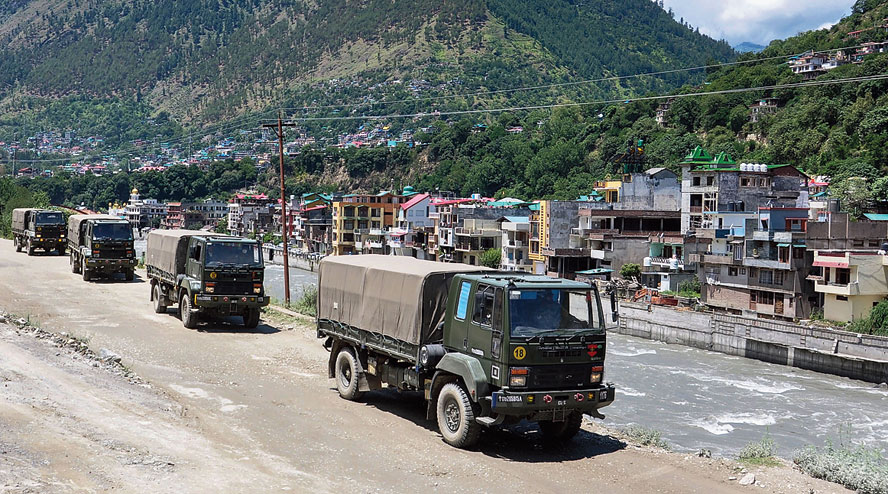India and China may be on the verge of a breakthrough in resolving the over six-month-long tense border standoff in eastern Ladakh with both sides broadly agreeing on a three-step process on disengagement of troops and withdrawal of weaponry from all major friction points in a time-bound manner, authoritative sources said on Wednesday.
The broad contours of the proposal include removal of armoured personnel carriers within one day of inking an agreement, withdrawal of troops from specific areas on the north and south banks of the Pangong lake in eastern Ladakh and carrying out verification of the disengagement process by both the sides, they said.
The specific proposals for the disengagement and restoration of the status quo ante as existed in April were finalised during the eighth round of high-level military talks between the Indian and Chinese armies in Chushul on November 6 on the Indian side of the Line of Actual Control(LAC).
The sources said both the Indian Army and the Chinese People's Liberation Army(PLA) are looking at sealing the pact in the next round of Corps Commander-level talks as the proposals were agreed to by the two sides.
The ninth round of military talks are likely to take place in the next few days.
Nearly 50,000 Indian Army troops are currently deployed in a high state of combat readiness in various mountainous locations in eastern Ladakh in sub-zero conditions as multiple rounds of talks between the two sides have not yielded concrete outcome to resolve the standoff.
China has also deployed an equal number of troops, according to officials. The standoff between the two sides erupted in early May.
As a first step, both sides will remove their tanks, artillery guns, armoured vehicles and large equipment from the friction points along the LAC to their rear bases within three days from inking the agreement, the sources said.
Under the second step, the PLA will go back to Finger 8 areas from their current position of Finger 4 on the north bank of Pangong lake while the Indian troops would position themselves close to the Dhan Singh Thapa post, the sources said. The mountain spurs in the area are referred to as Fingers.
It was broadly agreed to withdraw around 30 per cent of the troops every day for three days, they said.
In the third step, it was agreed to complete the disengagement process in areas along the southern bank of Pangong lake like Rezang La, Mukhpari and Magar hill.
Indian troops occupied a number of strategic heights in the Mukhpari, Rezang La and Magar hill areas around the southern bank of the Pangong lake, after the PLA soldiers attempted to intimidate them in the area on the intervening night of August 29 and 30.
"These are all proposals. There is no agreement signed yet," said a high-level source.
In the final phase of the disengagement process, both sides will carry out a detailed verification process following which normal patrolling is expected to resume, the sources said.
It is learnt that the top military brass deliberated on the proposals for disengagement and de-escalation of tension in eastern Ladakh before the eighth round of Corps Commander talks with the PLA.
The disengagement proposal in Finger areas will mean there will be no patrolling between Finger 4 and 8 areas till there is a resolution of the standoff. India used to patrol till Finger 8.
Army chief general M M Naravane on Tuesday said he was hopeful that the Indian and Chinese militaries will be able to reach an agreement on disengagement and de-escalation of tension in eastern Ladakh.
After the last round of military talks, both sides described the negotiations as candid, in-depth and constructive.
They said it was agreed to earnestly implement the important consensus reached by the leaders of the two countries and ensure that the frontline troops exercise restraint and avoid misunderstanding and miscalculation.
At the seventh round of talks too, both sides had agreed to maintain dialogue and communication through military and diplomatic channels to arrive at a mutually acceptable solution for disengagement "as early as possible".
India has all along been maintaining that the onus is on China to carry forward the process of disengagement and de-escalation at the friction points in the mountainous region.
Following the sixth round of military talks, the two sides announced a slew of decisions including not to send more troops to the frontline, refrain from unilaterally changing the situation on the ground and avoid taking any actions that may further complicate matters.
The sixth round of talks took place days after External Affairs Minister S Jaishankar and his Chinese counterpart Wang Yi reached a five-point agreement to resolve the row at a meeting in Moscow on September 10 on the sidelines of a Shanghai Cooperation Organisation(SCO) conclave.
The pact included measures like quick disengagement of troops, avoiding action that could escalate tensions, adherence to all agreements and protocols on border management and steps to restore peace along the LAC.










